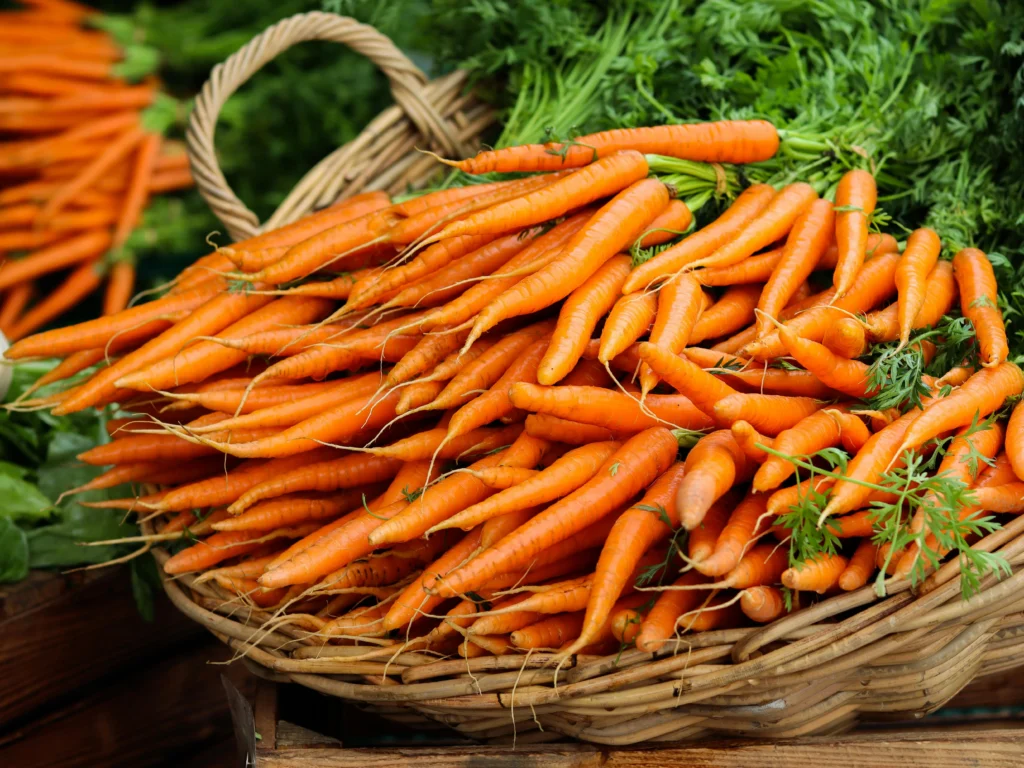10 Best Vegetables for Dogs: Simple & Healthy Guide
10 Best Vegetables for Dogs: Simple & Healthy Guide
10 Best Vegetables for Dogs: Simple & Healthy Guide
10 Best Vegetables for Dogs: Simple & Healthy Guide
23. Juni 2025
Feedback: 0
Vegetables for dogs – what can my dog eat and what not? You’re standing in the kitchen, chopping carrots and broccoli for your dinner – and your furry friend is sitting next to you with a loyal look on his face. Sure, he says: “Can I too?” My mixed-breed dog Bailey is absolutely crazy about vegetables. But not all vegetables are equally good for dogs – and some varieties can even be dangerous.
I’ve often asked myself: Is it really a good idea to feed my dog vegetables? Do I have to cook them or is raw enough? And why vegetables at all if dogs are carnivores?
In this article, I’ll show you why vegetables for Dogs can be a valuable addition to a dog’s diet, which varieties are particularly healthy, which you should leave out – and how best to prepare them so that your four-legged friend benefits from them.
Why vegetables for dogs at all?
Many people believe that dogs are pure carnivores – but this is not entirely true. In fact, dogs are omnivores. They are evolutionarily designed to eat both animal and plant foods.
The wild form of the dog – the wolf – eats mainly meat, but also the stomach contents of its prey, which include grasses, herbs and fruit. This experience has been preserved to this day in the digestive system of our domestic dog.
The benefits of vegetables for dogs
Vegetables provide important micronutrients that meat alone does not contain:
| Nutrients | Function |
|---|---|
| Vitamin A, C, K | and various B vitamins |
| Minerals | like potassium, magnesium & iron |
| Secondary plant substances | which have an anti-inflammatory and antioxidant effect |
| Antioxidants | Cell protection, strengthen the immune system |
| Dietary fiber | Promote healthy intestinal flora |
Vegetables are therefore an important pillar of a BARF diet or homemade dog food to ensure a balanced diet.
How many vegetables are allowed?
The rule of thumb is
10-15% of the daily food should consist of fruit and vegetables.
For an adult dog, this means around 50-150 g per day, spread over several meals, depending on its size.
If you are feeding BARF, experts recommend a proportion of approx. 7-10% vegetables in the total food, ideally with a varied composition.
Raw vs. Cooked Vegetables – What’s Better for Dogs?
This is a question that concerns many dog owners. The answer is: it depends!
◉ Raw vegetables: Raw vegetables contain all the natural vitamins and nutrients, some of which are lost during cooking. However, dogs have a hard time fully digesting raw veggies. That’s because their digestive enzymes aren’t made to break down plant cell walls. As a result, a large portion of raw vegetables is excreted undigested.
◉ Cooked vegetables: Cooking breaks down the cell walls, making nutrients more accessible. However, heat-sensitive vitamins like vitamin C can be lost in the process. It’s also important not to overcook the vegetables to preserve as many nutrients as possible.
◉ The perfect compromise Steaming: Our favorite: Steaming . Here, most of the nutrients are preserved, while the structure becomes soft enough for the body to optimally utilize the ingredients.
💡 Tipp 💡
If you give raw vegetables, grate them finely or puree them lightly – this will improve their absorption.
Steaming is the ultimate way In general, lightly cooked or steamed vegetables are often better for dogs, as they aid digestion and make nutrients more readily available. According to Futtermedicus, cooked vegetables can even help to stabilize the intestinal environment – a benefit that can be particularly valuable for sensitive dogs.
Our top 10: Healthy vegetables for dogs
Here are some healthy vegetables for dogs that you can feed without worrying:
◉ Carrots: Rich in beta-carotene and great for eye health.
◉ Broccoli: High in vitamin C and fiber. Caution: Feed only in small amounts!
◉ Zucchini: Low in calories and easy to digest.
◉ Pumpkin: Helps with digestive issues and is high in fiber.
◉ Spinach leaves: Rich in iron, but should be given in moderation.
◉ Fennel: Supports digestion and is enjoyed by many dogs.
◉ Parsnips: Easily digestible, rich in vitamins C and E, and supports the immune system.
◉ Bell Pepper (Red/Yellow): Rich in vitamin C.
◉ Celery: Can help stimulate appetite.
◉ Chicory: Supports liver function and should be steamed before feeding.
Caution: These foods are poisonous for dogs!
Unfortunately, there are also some vegetables that can be poisonous or even life-threatening. You should never feed them to your dog:
◉ Onions and leeks: Can cause severe changes in the blood profile.
◉ Raw potatoes: Contain solanine, which is toxic.
◉ Avocado: Contains persin, which can be harmful to dogs.
◉ Rhubarb: The leaves contain oxalic acid, which can promote kidney stones.
◉ Beans: Contain phytohemagglutinin, a toxin that must be destroyed by cooking.
Read more here: Dangerous foods for dogs
How to Steam Vegetables for Dogs – Step by Step
Time to get practical! Here’s a quick guide to steaming veggies the right way:
◉ 1. Choose suitable vegetables: (see list above).
◉ 2. Wash the vegetables thoroughly: Make sure there are no pesticides or residues left. (If possible, vegetables from your own garden are best.)
◉ 3. Cut the vegetables into small pieces: Small pieces cook faster and more evenly. They’re also easier for your dog to eat.
◉ 4. Steam the vegetables: Place the vegetables in a pot with a little water or use a steamer. Steam them for about 5–10 minutes until soft but still slightly firm.
◉ 5. Let the vegetables cool: Hot vegetables can burn your dog’s mouth. Wait until they’ve reached room temperature.
◉ 6. Puree (optional): For better digestibility, you can puree the vegetables. This is especially helpful for sensitive dogs.
Practical tip: Preparing and storing vegetables
To save time, you can prepare larger quantities of vegetables once a week and freeze them in portions. That way, you’ll always have something there when you need it.
Beispiel-Routine:
◉ Monday evening: Mix 500g of vegetables, steam, portion out and freeze.
◉ During the day:: Thaw one portion and mix it into your dog’s food.
This saves you time and ensures a varied, nutritious diet.
Frequently Asked Questions About Vegetables for Dogs
Can my dog eat vegetables every day?
Yes, in moderate amounts. Around 10–15% of your dog’s daily food intake should come from vegetables.
Can I give vegetables to my puppy?
Yes, but only gently prepared and in small quantities. Sensitive puppies have delicate digestive systems and require adjusted feeding.
Is organic vegetables better?
Organic is definitely preferable since it contains no pesticides. If not available, thorough washing is essential.
How often should I change the type of vegetable?
Switch varieties every 1–2 weeks to ensure a balanced supply of micronutrients.
Can senior dogs eat vegetables too?
Yes – older dogs especially benefit from fiber and secondary plant compounds. However, make sure the vegetables are easy to digest.
Does every dog need vegetables?
No – but vegetables offer many benefits. If your dog has specific health conditions or sensitivities, consult with your veterinarian before adding them to the diet.
Nutrient table for reference
| Vegetables | Vitamin A | Vitamin C | Potassium | Iron | Dietary fiber |
|---|---|---|---|---|---|
| Carrot | ✅ | ❌ | ✅ | ❌ | ✅ |
| Broccoli | ✅ | ✅ | ✅ | ✅ | ✅ |
| Zuccini | ❌ | ✅ | ✅ | ❌ | ✅ |
| Pumpkin | ✅ | ✅ | ✅ | ❌ | ✅ |
| Spinach | ✅ | ✅ | ✅ | ✅ | ✅ |
| Peppers | ✅ | ✅ | ✅ | ❌ | ✅ |
| Fennel | ❌ | ✅ | ✅ | ✅ | ✅ |
Conclusion: Why Veggies Are a Win for Dogs
Adding vegetables to your dog’s diet is one of the easiest ways to support their health naturally. Whether steamed, mashed, or lightly raw – if you choose the right types and prepare them with care, your pup will love the extra boost.
Share, comment, follow – stay tuned!
If you liked this article, please share it with other dog lovers. Do you have your own experiences with vegetables for your dog? Then leave us a comment – we look forward to hearing from you!
❤️🐾 See you next time
Bailey and her owner

Wir sind zwei deutsche Auswanderer und auf emigres-life nehmen wir Dich mit auf unsere Reise in ein neues Leben.
In unserem Projekt schwingt das Pendel meist in Richtung stressig oder chaotisch und weniger in Richtung tiefenentspannt.
Wenn du also wissen willst, in welches Fettnäpfchen wir als nächstes treten oder welche Hürden vor uns liegen und wie wir sie überwinden, dann bleib dran.
Nächster Blogpost
Heatwave in Spain – Our experience at 42 °C, Uncensored
Vorhergehender Blogpost
10. gesunde Gemüse für Hunde: Roh oder gekocht? So funktioniert’s effektiv



 Pin it!
Pin it!

